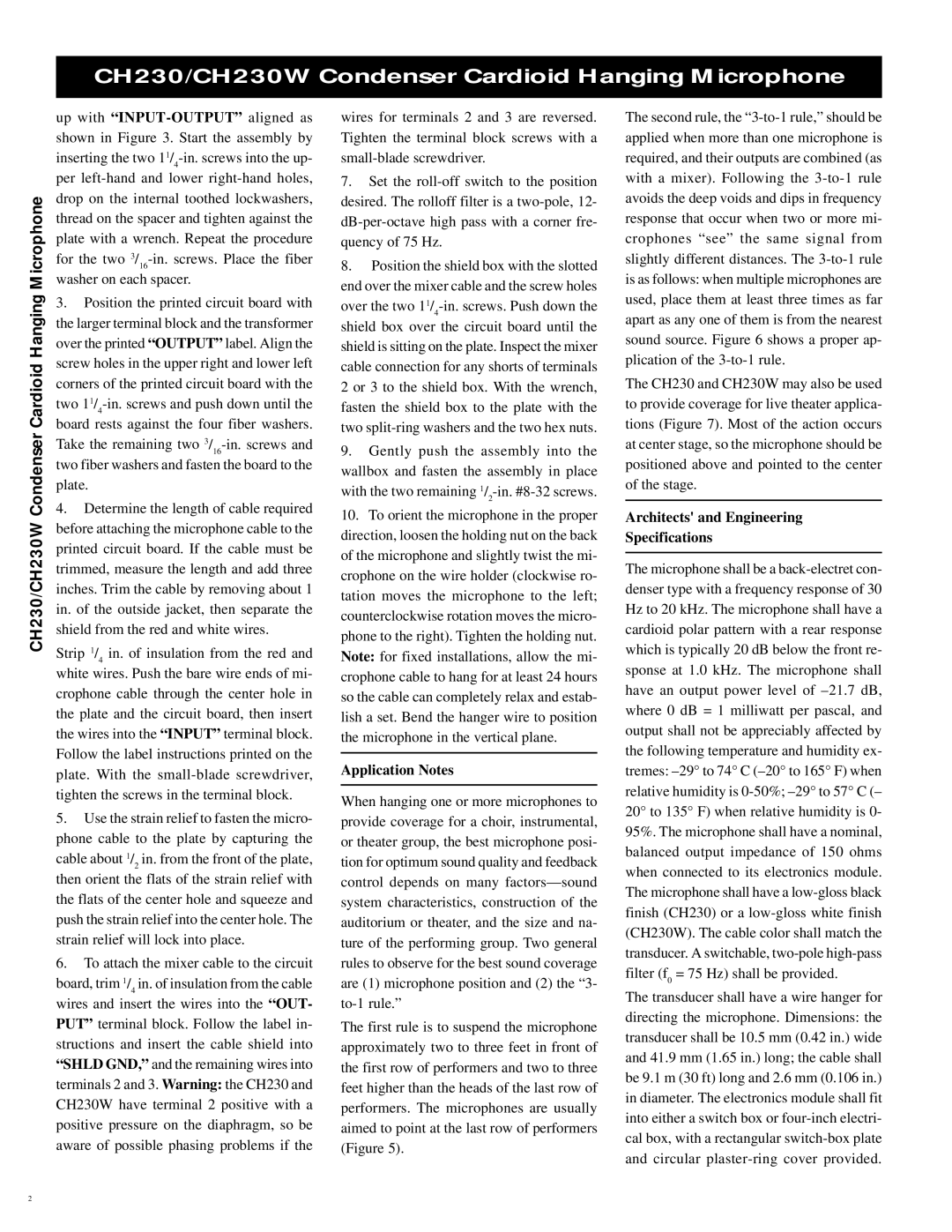
CH230/CH230W Condenser Cardioid Hanging Microphone
CH230/CH230W Condenser Cardioid Hanging Microphone
up with
3.Position the printed circuit board with the larger terminal block and the transformer over the printed “OUTPUT” label. Align the screw holes in the upper right and lower left corners of the printed circuit board with the
two
Take the remaining two
plate.
4.Determine the length of cable required before attaching the microphone cable to the printed circuit board. If the cable must be trimmed, measure the length and add three inches. Trim the cable by removing about 1 in. of the outside jacket, then separate the shield from the red and white wires.
Strip 1/4 in. of insulation from the red and white wires. Push the bare wire ends of mi- crophone cable through the center hole in the plate and the circuit board, then insert the wires into the “INPUT” terminal block. Follow the label instructions printed on the plate. With the
5.Use the strain relief to fasten the micro- phone cable to the plate by capturing the
cable about 1/2 in. from the front of the plate, then orient the flats of the strain relief with
the flats of the center hole and squeeze and push the strain relief into the center hole. The strain relief will lock into place.
6.To attach the mixer cable to the circuit
board, trim 1/4 in. of insulation from the cable wires and insert the wires into the “OUT-
PUT” terminal block. Follow the label in- structions and insert the cable shield into “SHLD GND,” and the remaining wires into terminals 2 and 3. Warning: the CH230 and CH230W have terminal 2 positive with a positive pressure on the diaphragm, so be aware of possible phasing problems if the
wires for terminals 2 and 3 are reversed. Tighten the terminal block screws with a
7.Set the
8.Position the shield box with the slotted end over the mixer cable and the screw holes
over the two
shield is sitting on the plate. Inspect the mixer cable connection for any shorts of terminals
2or 3 to the shield box. With the wrench, fasten the shield box to the plate with the two
9.Gently push the assembly into the wallbox and fasten the assembly in place with the two remaining
10.To orient the microphone in the proper direction, loosen the holding nut on the back of the microphone and slightly twist the mi- crophone on the wire holder (clockwise ro-
tation moves the microphone to the left; counterclockwise rotation moves the micro- phone to the right). Tighten the holding nut. Note: for fixed installations, allow the mi- crophone cable to hang for at least 24 hours so the cable can completely relax and estab- lish a set. Bend the hanger wire to position the microphone in the vertical plane.
Application Notes
When hanging one or more microphones to provide coverage for a choir, instrumental, or theater group, the best microphone posi- tion for optimum sound quality and feedback control depends on many
The first rule is to suspend the microphone approximately two to three feet in front of the first row of performers and two to three feet higher than the heads of the last row of performers. The microphones are usually aimed to point at the last row of performers (Figure 5).
The second rule, the
The CH230 and CH230W may also be used to provide coverage for live theater applica- tions (Figure 7). Most of the action occurs at center stage, so the microphone should be positioned above and pointed to the center of the stage.
Architects' and Engineering
Specifications
The microphone shall be a
The transducer shall have a wire hanger for directing the microphone. Dimensions: the transducer shall be 10.5 mm (0.42 in.) wide and 41.9 mm (1.65 in.) long; the cable shall be 9.1 m (30 ft) long and 2.6 mm (0.106 in.) in diameter. The electronics module shall fit into either a switch box or
2
